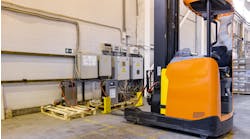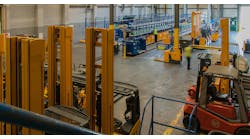Andel and Handling: How Automation and Labor are Changing Each Other
This edition of MH&L has several features on trends in automated material handling—from conveyors to control systems to the management of the "Big Data" that come from these systems. But the challenge underlying these trends is maintaining the talent to support automation. In our news section you'll see a story on Dematic's expansion beyond systems automation to preventative maintenance with its acquisition of a provider of computerized maintenance management systems (CMMS). This is a sign of our times.
You're sure to see more automation OEMs become more vertically integrated in the support of their systems. They know it's not only getting harder for their customers to draw talent to work in their distribution centers, but also to manage the automation being put to work with them.
While contacting several sources in preparing this content, the talent theme kept coming up. Even the automation suppliers themselves acknowledge that no matter how sophisticated you get with technology, it's hard to beat the flexibility of the human being.
"In order picking, steps such as packing and handling cannot yet be carried out automatically in an optimum manner," says Dr. Christoph Beumer, president and CEO of BEUMER Group. "I can see difficulties for technology, particularly when an enormous range of items and a rapidly changing stock are involved. This requires a highly flexible system which must be capable of repeatedly adapting itself to new products. No machine today can outperform a human being."
Greg Cronin, executive vice president at Intelligrated, told me there are ways automation can make best use of the labor in a distribution center. He agrees with Beumer that picking is the biggest challenge, but we will be seeing smarter uses for automation that had been ignored for years by many companies in favor of cheaper labor. This automation will make today's labor more efficient in their movements.
"Automated storage and retrieval systems are making a return," he says. "That's because a lot of our customers buy ahead and build pallets in advance for store delivery and they store these pallet loads so they can quickly stage them in a certain sequence in their trailer."
But what about the surge in e-commerce, where companies must deal in eaches?
"The difficulty in a DC is how you pick those three different items for an order which can be in three completely different areas of the warehouse," he continues. "That means getting those three different product types to come together into one central accumulation point and packaged into one carton."
That's where goods to operator automation is making its mark. The machinery brings the goods to the picker from many different places throughout a facility. Alternatively, pickers can pick from various places in a warehouse, place their items on a conveyor and that conveyor will bring them to a put wall for order consolidation by a person. What's key here, though, is those people need constant input on their productivity so they can meet and beat their performance goals. That's where automated information gathering is filling the gap left by a thinner workforce.
"Every site we do today needs these types of capabilities," Cronin says. "It's the nature of the people they're hiring. They would rather work with tools like that than the old fashioned way of walking and looking. They want to see how they're doing compared to everybody else. Using big flat screens people can see how they're doing graphically and make sure they're keeping up with what's coming and what's happening next."
The key word where operators are concerned is "graphic." Cronin says people don't want to deal with numbers anymore, they want to get a birds-eye view of the physical layout of the operation, with everything color coded to say how they're doing: ahead, on time or behind.
Russ Rasmus, global manufacturing leader and managing director in the global manufacturing consulting practice at Accenture, confirms the trend toward better use of analytics and simulation technology. And as the workplace adapts to the availability of fewer workers, workers will have to start adapting to the new distribution environment.
"An operator that used to have a lot of manual skills now needs digital skills," he says. "That means manufacturers either need to invest in training their existing resources or they need to recruit the talent to have them operate their plant more efficiently. That's why manufacturers are investing in quality systems, lab systems and performance dashboards for the plant environment. They're getting better visibility to data not only within one plant but across a network of plants."
There's an ancient bit of wisdom about the need for situational flexibility that states "If the mountain will not come to Muhammad, then Muhammad must go to the mountain." It seems like manufacturers are graduating to a new business philosophy: "If you can't get enough workers to come to your plants, bring your plant data to them."
Follow me on Twitter @TomAndel.


